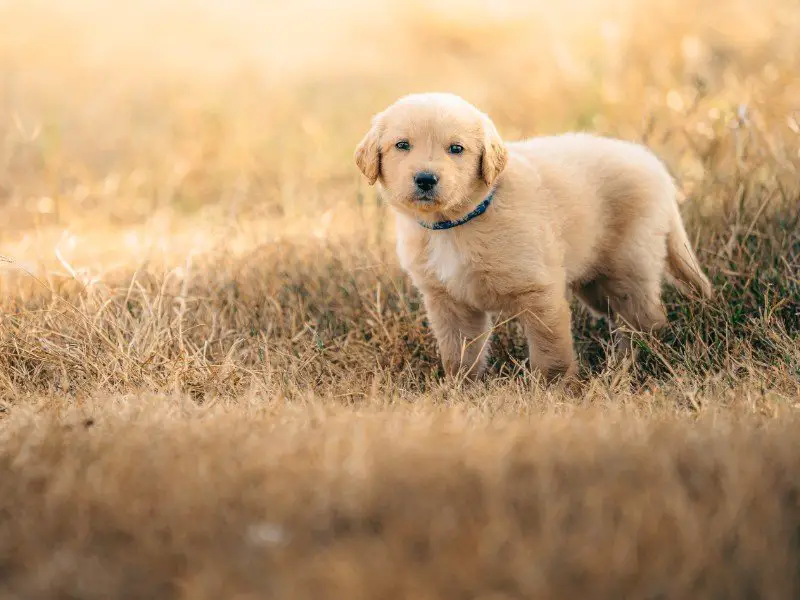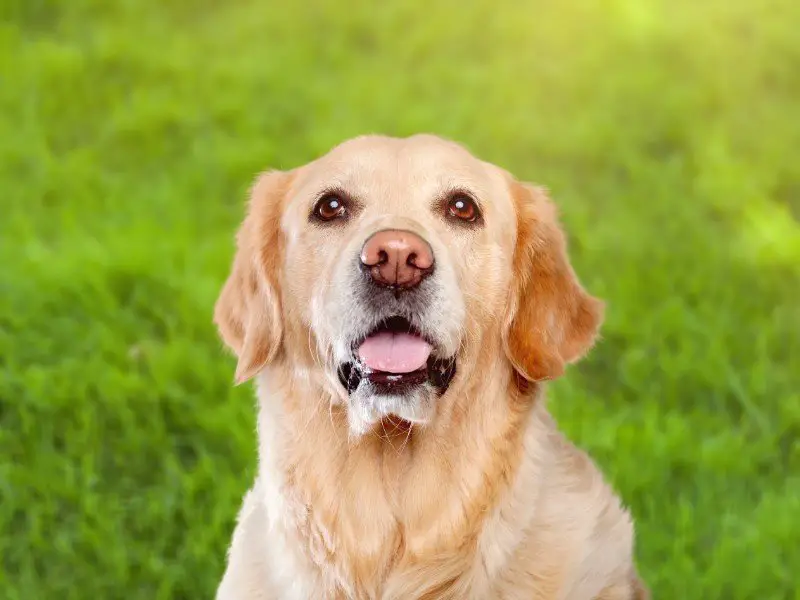The golden retriever lab mix is a cross between a golden retriever and a Labrador retriever. Golden retriever lab mixes are also commonly referred to as goldadors, golden Labradors, and golden labs.
Golden retriever lab mixes are large dogs that reach 24.5 inches tall and weigh between 55 and 80 pounds. Goldadors are playful, gentle, and get along well with children, making the dogs well-suited to families. The mixed breed has an average lifespan of 10 to 12 years.
While generally easy to care for, golden retriever lab mixes need plenty of exercise and mental stimulation throughout the day, so they’re not suitable for busy, inactive people. Goldadors typically cost $150 to $1,000.
TABLE OF CONTENTS
Goldador Characteristics & Overview

| Common names | Golden retriever lab mix, goldador, golden Labrador, golden lab |
| Weight | 55–80 pounds |
| Temperament | Loyal, friendly, affectionate, eager to please |
| Size | Large |
| Shedding | Moderate to heavy |
| Parent breeds | Golden retriever and Labrador retriever |
| Origin | Britain, Newfoundland |
| Life expectancy | 10–12 years |
| Height | 21.5–24.5 inches |
| Cost | $150–$1,000 |
| Colors | Gold, yellow, black, chocolate |
| Coat | Double coat |
| Breed group | Hybrid |
| Barking tendency | Low to moderate |
Origin & Purpose
Golden retriever lab mixes have appeared throughout history, but the intentional breeding of these dogs began around a decade ago. Golden retrievers and Labradors were crossed together to develop a working dog that was highly trainable, tolerant, and sensitive, all ideal qualities for service work.
Golden Retriever
Golden retrievers have their origins in 19th-century Scotland. The breed was developed by Sir Dudley Marjoribanks, a Scottish businessman and liberal politician, who bred water Spaniels with other working breeds to create a dog that was loyal, highly trainable, and excellent at retrieving. Golden retrievers were recognized by the American Kennel Club (AKC) in 1925.
Goldadors often inherit the affectionate nature and athletic build of the golden retriever.
Labrador Retriever
Labrador retrievers were first bred in Newfoundland, Canada, in the 19th century, and were used to retrieve waterfowl and fishing nets from the water. They were later imported to England, where the dogs were further selectively-bred to exhibit the traits known and loved today. Labradors were recognized as a breed by the AKC in 1917.
Goldadors usually inherit the Labrador retriever’s water-resistant coat and high work drive.
Lifespan
Golden retriever lab mixes have an average lifespan of 10 to 12 years, as long as their needs are met. Plenty of exercise, a nutritious diet, and regular vet checkups help these dogs live long, healthy lives.
Golden Retriever Lab Mix Appearance

Goldadors are large dogs with muscular builds, affectionate eyes, and broad muzzles. Their coat appearance varies, depending on which genes they inherit from their parents.
Height and Weight
Golden retriever lab mixes are considered large dogs, with a height at the withers of 21.5 to 24.5 inches, and a weight of 55 to 80 pounds. Males are larger and broader than females.
At eight weeks old, goldador puppies weigh around 10 pounds. These dogs reach their full height within 12 months, though their weight can vary throughout their lives depending on diet, activity, metabolism, and other health factors.
Colors
Golden retriever lab mixes are typically shades of gold, yellow, black, or chocolate. The rarest goldador coat color is white, though this color isn’t part of either parent breed’s standard. Some goldadors have white markings on their chests.
Coat
Goldadors have thick, double coats with dense hairs. The exact appearance of the coat depends on whether the dog has inherited the Labrador’s coat or the golden retriever’s coat.
- Labrador coat: Short, straight outer coat with a soft water-resistant undercoat
- Golden retriever coat: Water-repellent outer coat made up of straight or wavy hairs. Heavy feathering on the chest, tail, and legs
Golden retriever lab mixes shed moderately throughout the year, but have heavy shedding periods during the fall and spring when they blow their coats.
Goldador Personality and Temperament
Golden retriever lab mixes are loyal, playful, affectionate, sociable, and get along well with children and other pets. These dogs are intelligent and love nothing more than pleasing their owners, which makes them easy to train.
Goldadors are energetic dogs that are best suited to owners that lead active lifestyles and have time to play with the dogs throughout the day. While gentle, goldadors can be mouthy and love to retrieve items around the house, so they’ll need plenty of chew toys and training from an early age to curb this behavior.
Barking
Goldadors are quiet dogs that rarely bark if they’re properly trained and cared for. They’re friendly to strangers and other animals, and typically only vocalize when they’re bored, excited, or stressed. Early training and socialization can help prevent excessive barking.
Golden Retriever Lab Mix Care
Golden retriever lab mixes are moderately difficult to look after. While trainable and rarely aggressive, these dogs are energetic, have high-maintenance coats, and need lots of attention.
The mixed-breed also requires plenty of mental stimulation throughout the day to prevent them from boredom and destructive behaviors.
Food Needs
Golden retriever lab mixes require 2 to 3.5 cups of high-quality dog kibble per day, split across two meals. The food must be formulated for large dogs and be packed with nutrients. The exact amount to feed a goldador depends on its activity level, metabolism, age, and size.
Goldador puppies grow rapidly and reach their full adult size within 18 months. Puppies should be fed food that’s rich in protein to support their fast growth.
Golden retriever lab mixes have voracious appetites and put on weight quickly if overfed. Obesity can lead to several health issues including heart disease, joint problems, and diabetes. Use a calorie calculator to determine whether you’re feeding your dog too little or too much food.
Grooming Needs
Golden retriever lab mixes are heavy shedders and need daily brushing to keep their fur free of tangles, debris, and excess hair. Brush in the direction the fur grows, and use a slicker brush to tackle feathered areas. Goldadors need bathing once every month or whenever they get dirty.
While grooming, check these dogs’ ears and skin for signs of infection, ticks, or fleas. You should also brush the dogs’ teeth two to four times a week to maintain good dental hygiene.
Exercise Needs
Goldadors are energetic dogs that require one to two hours of exercise per day to stay physically fit. Ideal activities include walking, hiking, running, swimming, agility, and interactive games.
Golden retriever lab mixes do best in houses with backyards, where they can easily play and stretch out their legs.
Mental Needs
Goldadors are intelligent dogs that need at least an hour of mental stimulation per day, in the form of learning new tricks, agility, water games, and playing with toys. Golden retriever lab mixes particularly love to fetch.
Common Health Concerns
While golden retriever lab mixes are healthy dogs, they’re prone to the conditions their parents suffer from, including bloat, cancers, hip and elbow dysplasia, and ichthyosis.
- Bloat: A life-threatening condition where gas, liquid, or food gets trapped in the dog’s stomach, causing it to expand and twist. Symptoms include severe pain, excessive drooling, rapid heartbeat, retching, and lethargy. Dogs suffering from bloat should be taken to a veterinarian immediately for treatment
- Hemangiosarcoma: A tumor arising from the cells that line blood vessels. The symptoms vary based on the location of the main tumor but include lumps, an irregular heartbeat, weakness, lethargy, and pale gums. Treatment involves palliative care, chemotherapy, and surgery
- Bone cancer: A malignant tumor in the bone cells, called osteosarcoma. The symptoms include a visible mass, loss of appetite, panting, elevated heart rate, lethargy, pain while exercising, and limping. Bone cancer is treated and managed with chemotherapy and surgery
- Lymphoma: Cancer that develops in the lymphatic system. Symptoms include enlarged lymph nodes, weight loss, lethargy, breathing difficulties, and increased thirst. Chemotherapy can help prolong the dog’s life
- Hip and elbow dysplasia: Abnormal formation of the dog’s hip or elbow joints. Symptoms include pain, reduced activity, lameness, and limping. Hip and elbow dysplasia can both be managed with physiotherapy, medication, surgery, and lifestyle changes
- Ichthyosis: A rare skin condition that causes scaling and thickening of the outer skin layer. Treatment involves frequent grooming and washing, moisturizing, and topical medications
- Ear infections: When harmful bacteria or yeast builds up in the ear canal, causing pain, inflammation, and irritation. Ear infections can be treated with medicated ear cleansers
- Hypothyroidism: When the dog’s thyroid doesn’t work properly, causing weight gain, lethargy, thinning fur, and cold sensitivity. Hypothyroidism is treatable with thyroid hormone replacement therapy
Goldadors are also prone to a range of eye problems, including:
- Retinal dysplasia: An abnormal formation of the retina that causes vision issues. There is no known treatment for this condition
- Progressive retinal atrophy (PRA): A disease that causes the retina to gradually deteriorate, eventually leading to permanent blindness. No treatment is available for PRA
- Cataracts: A cloudy patch on the lens of the eye, causing vision problems. Cataracts can be removed with surgery, though most dogs cope well with the vision loss
Golden Retriever Lab Mix Training

Golden retriever lab mixes are easy to train because of their intelligence, strong focus, and eagerness to please. These dogs love learning new tricks and can pick up complex tasks, which makes them well-suited for service work.
Training can start as early as eight weeks and should begin with name training, crate training, housebreaking, and basic obedience. Puppies should also be socialized throughout their lives, especially between the ages of 8 and 16 weeks, to help them become outgoing, even-tempered adult dogs.
Goldadors respond best to positive reinforcement, with rewards such as high-value treats and toys. Always acknowledge and praise desirable behaviors.
Golden retriever lab mixes are mouthy, so they need plenty of bite inhibition training. Whenever the puppy bites you, make a yelping noise and turn away from them. Don’t give them any attention until their behavior subsides. You can also redirect their mouthiness by giving the dogs durable toys to chew.
Goldador Price
Goldadors are popular mixed breed dogs and are moderately expensive to buy. The price depends on whether you adopt these dogs from rescue shelters or buy them from breeders.
How Much Is a Golden Retriever Lab Mix?
A golden retriever lab mix typically costs $150 to $1,000. Adopting an adult from a rescue shelter incurs a fee of $50 to $250, while puppies from reputable breeders can cost up to $1,500. The exact price depends on the dog’s age, health, bloodline, and appearance.
How Much Does it Cost to Own a Goldador?
Expect to pay between $100 and $180 per month on a goldador dog’s food, healthcare, toys, and grooming. First-year expenses are higher than subsequent years because of initial vet fees, vaccinations, training, bedding, and walking supplies.
You should also budget for dog walkers, dog sitters, and training classes if you and your dog will benefit from these services.
Is a Golden Retriever Lab Mix Right for You?
Golden retriever lab mixes are gentle, playful, and sociable dogs that make wonderful family companions. While easy to train, these dogs can be difficult to care for because of their large size, endless amount of energy, and potential mouthiness, so they aren’t ideal for all people and lifestyles.
Golden Retriever Lab Mixes Are Suitable for:
The best owners for goldadors are people that are prepared to walk, play with, groom, and train a dog daily. Because Golden retriever lab mixes are gentle and patient, they’re particularly ideal for families with young children or other pets.
Goldadors are large, energetic dogs that do best in spacious households with backyards.
Golden Retriever Lab Mixes Are NOT Suitable for:
Golden retriever lab mixes aren’t suitable for people that are inactive, have mobility issues, or can’t groom a dog regularly. Goldadors are heavy shedders, so people who suffer from allergies, or like to keep their house spotless, should also avoid having a pet of this mixed breed.
Golden retriever lab mixes are sociable and prone to separation anxiety, so they aren’t suitable for people that work long hours or lead busy lifestyles.

Be the first to comment